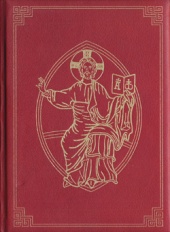Liturgical Language and
the Roman Missal
Rev. Msgr. Charles E. Singler
This article, which appeared in the 09 October 2010 issue of the Catholic Chronicle, the newspaper of the Diocese of Toledo OH, and is reprinted with the kind permission of the author.

Whenever I have asked what particular aspects of the Sunday Mass inspire them, people often comment on the visual or ritual elements they see with their eyes or they comment on the audible aspects that are heard in the musical selections.
While it may be implicit in the visual and audible observations made, few comments people make in general have anything to do with the content of the prayer texts spoken or sung and what those words might mean.
There are several ways to interpret the absence of such comments.
Either those who participate at Mass are tuned out to other distractions going on around them, or they may have difficulty connecting to spiritual language.
It is this latter perspective that I would like to address in this brief essay in light of the publication of the English translation of the Third Edition of the Roman Missal that is implemented in 2011.
While it is true that the use of vernacular language in the liturgical reform of the Second Vatican Council had as its aim a desire for greater understanding and active participation, something can be lost in the use of secular language when speaking of spiritual realities.
That, in reality, is one of the core issues prompting the publication of the new translation of the Roman Missal.
At a linguistic level, if the English texts we pray in common at the liturgy are translated from another language (Latin), would not some words in the vernacular (what we use in English) have the potential to mean something slightly or even abruptly different in the original language?
And if language was the fact posing concern, could it not be said that the theological or spiritual meaning of words could take on a meaning not intended by the Church?
That, in fact, has been part of the issue with the old Sacramentary translation used in English speaking countries until 2011.
Liturgical language is a unique language, not because it desires to promote lofty, unattainable facts about faith, but because it unites the Mystical Body of Christ, the Church, in space and time, to images familiar to the Catholic faith.
The revised Roman Missal texts connect us to our liturgical heritage to words that have transcended time.
The words and phrases which may sound new to our ears and on our lips are woven tightly to a strong biblical and doctrinal tradition.
One of the concerns that some have expressed over this new translation is the ability of the faithful to comprehend the spiritual depth and meaning of some words and images.
If we consider the fact that what we do in the liturgy is formational in the way of living the Christian life, then perhaps the new Roman Missal translation can be a "teachable moment" to look at what we believe as Catholic Christians differently.
Certainly, some words and phrases that have been our common response the past 40 years and have now been changed may cause us to re-consider what we have been saying and ultimately, what we essentially believe in faith.
The doomsayers of the third edition Roman Missal translation will undoubtedly run to the familiar adage: "You can't teach an old dog new tricks."
To those who harbor such a thought, we might respond that the People of God are not old dogs.
While we are creatures of habit, we learn to adapt to things that change in our lives.
People who learn that they have a medical condition, for instance, learn to adapt to the diagnosis by altering their lifestyle.
If need be, they augment the situation with medication.
The point is that we adapt to change in our life.
The same is true for the spiritual tides we encounter in life.
The Third Edition of the Roman Missal presents some new words and images to our common prayer at Mass.
If the Catholic faithful consider those words and images and their meaning anew, perhaps our perception of God, the world and our very selves might bring about a new springtime in faith.
If that is true, perhaps the intent of the Second Vatican Council reforms will once again be reenergized.
Msgr. Charles E. Singler, D. Min., is director of worship for the Diocese of Toledo.
Copyright © 2010 Catholic Chronicle.
Used by permission.
| 

